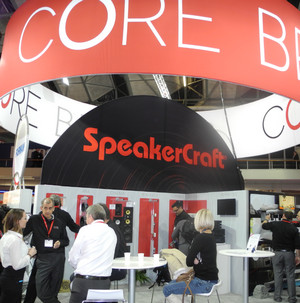There were some subtle changes to the Core Brands booth at ISE 2015 in Amsterdam last month, but they represented some large initiatives within the Nortek (Nasdaq: NTK) group that includes Elan Home Systems (home automation); Niles, SpeakerCraft and Proficient (speakers and multiroom audio); Panamax and Furman (power management and conditioning); Xantech (signal routing and control); and Sunfire (subwoofers).
CE Pro sat down with Core Brands president Joe Roberts at the show – his first event in this new role, after taking over from Bill Pollock in October 2014.
Instead of treating all brands (mostly) equal under the ISE tradeshow header, Core Brands played favourites, emphasising the “core brands” that built the organisation.
Key among them: SpeakerCraft, which dominated the ISE booth.
Last year, Roberts explains, the team convened to determine, “What’s going to really move the needle for Core Brands?”
It had to be the “heritage” businesses, they all agreed.
In the recent past, some of Core’s marquee brands got lost in a fray that includes (included?) such secondary lines as Aton (Cat 5 digital audio), Korus (DIY wireless audio) and BlueBolt (power management software for Panamax and Furman).
That didn’t happen at ISE, where Core Brands unapologetically played favorites.
The poster child for Core’s return to its roots is SpeakerCraft, which benefited from large R&D development in the past couple of years and a huge display at ISE.
“I don’t know how long we haven’t worked on speakers,” Roberts says, “but we went into overdrive.”
The Return of SpeakerCraft

At CEDIA 2014 last September, SpeakerCraft introduced the second version of its iconic AIM pivoting speakers. AIM Series 2 comprises 13 models, developed with an army of acoustic, mechanical and industrial designers, according to Roberts.
“Almost every [manufacturing] tool is new,” he says. “There’s a whole new crossover network, all new electronics, new magnets, new drivers…”
What makes the line particularly unique is what SpeakerCraft calls the Arc Tweeter Array, and what Roberts calls “the game changer”.
Modeled after the massive arced speaker arrays at outdoor concerts, the arced tweeters in the AIM 2 speakers allow for a lower crossover point, “delivering the benefits of a three-way design in a two-way speakers,” according to SpeakerCraft.
The architecture allows for a more uniform, wider high-frequency coverage area for increased vertical directivity and reduced floor and ceiling bounce.
The arrays rotate and pivot; the entire speaker assembly can rotate as well.
SpeakerCraft uses co-molding– molding two materials or colors of materials to create a single integrated part – for acoustic isolation.
The co-molded material is pliable, yet sturdy and reduces transference from mechanical vibration to acoustic vibration, according to Roberts.
“No one’s done that before,” he says.
He adds, “There isn’t Atmos certification for in-ceiling speakers yet, but these are definitely Atmos-worthy.”
More importantly, “It’s not just a bunch of engineers saying, ‘This is the best,’” says Bill Hensley, director of marketing for Core Brands. “But we bring in the sales team and ask, ‘Is this true to the SpeakerCraft heritage?’”
Between the product vetting by SpeakerCraft engineers, sales reps and dealers, the AIM 2 products went back for tweaks multiple times as the company tested the speakers against the competition.
“By final voicing,” Roberts says, “there are no competitors.”
The products are shipping soon, according to Roberts: “They’re on the boat.”
SpeakerCraft also just began shipping a brand new multiroom audio system, the 6×12 MRA-664 – one of a growing line of reimagined electronics for the brand.
Niles Auriel, Powered by Elan
SpeakerCraft wasn’t the only Core Brands company to get a new whole-house audio system.
Last year, Niles launched the MRC-6430, aka Auriel, which is much more than a 6×6 audio distribution system. It also has most of an Elan g1 processor inside, meaning it’s ready to serve as a home automation platform.
Compared to the g1, the Auriel is “limited in software” but still benefits from much of the software development for Elan.
For example, Elan developed a two-way Sonos driver that Roberts says is “the most responsive Sonos integration out there because it talks directly to the [Sonos] service.”
The driver now can be easily ported to Auriel.
Today, you can’t control lights and thermostats with Auriel because Niles wants to keep the product simple enough to sell through distribution.
“Right now, it’s limited to what we have that is Wizard-based,” Roberts says, “but the power is there.”
Also there are the interfaces currently available for Elan, such as the TP7 touchscreen and KP7 keypad, providing an easy upgrade path to a complete Elan home automation system.
“It gives us economies of scale,” says Roberts. “As we develop for Elan, it cascades to Niles.”
Elan, by the way, has a “whole new architecture, both hardware and software,” says Roberts, who is particularly excited about the new g1.
“It really opens up new doors,” he says of the sub-$1,000 product. “It’s very scalable but so simple and priced for high volume.”
The product is easier for dealers, as well, with a new simplified licensing model.
It’s the Software, Stupid
Auriel is a prime example of a “strong emphasis on software” at Core Brands.
Roberts says the organisation consolidated all of its software engineers into a single team last year to share resources and enhance the user experience across brands and product lines.
At the same time, Core Brands is adding to its third-party API team and implementing the Lua programming language so others can write drivers as well.
More on Core Brands…
Core Brands Gifts US Veteran With Smart Home

